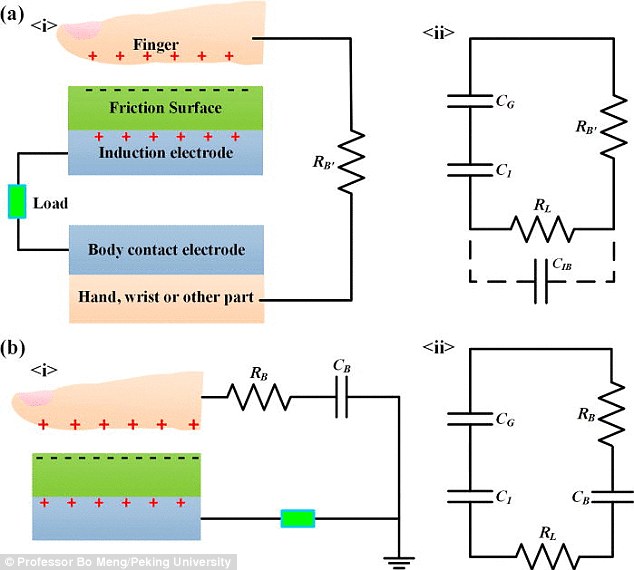Human batteries may have seemed a little far-fetched when the Matrix film was released in 1999, but 15 years on, researchers could be about to make it a reality.
Meng Bo from Peking University has built a generator capable of charging a mobile phone using electrons produced by our bodies.
The device, called a single-friction-surface triboelectric generator (STEG), produces a charge when a finger or palm taps a layer of conductive material attached to a device.

Researchers from Beijing fitted a phone with a layer of materials that generates an electric charge when rubbed together. Tapping the phone caused electrons to move from the skin to the phone and repeated tapping caused this charge to move into a generator, diagram pictured.
This generator uses what’s known as the triboelectric effect, also known as triboelectric charging.
When certain materials are rubbed together, the friction causes a build-up of electric charge between the two objects.
Static electricity is an example of triboelectric charging, and the strength of the charge differs depending on the materials being used.
The Beijing-based researchers previously created a generator capable of harnessing this triboelectric charge using a grounded electrode, but recently replaced it with a ‘body contact’ version.
During recent tests, published in the Applied Physics Letters, Professor Meng and his team fitted a mobile phone with a transparent layer of STEG composite material.

In 1999 film The Matrix, human bodies were wired up to machines and used as batteries, still pictured. Last year, Fujifilm demonstrated a thermoelectric conversion material that turns changes in body temperature into an electrical charge.
The body contact electrode was then fitted to the side of the device, and the user’s finger or palm.
As a user tapped the STEG material layer, electrons were moved between the skin and the phone.
Repeated tapping caused this charge to move between the charged skin and the electrode, which in turn harnessed the energy. This energy could then be used to charge the phone, or other low-power devices.
Researchers also discovered that the body contact electrode performed better, and harnessed more energy, than the previous grounded electrode.

The generator uses triboelectric charging. When certain materials are rubbed together, the friction causes a build-up of charge. The researchers previously created a generator capable of harnessing this charge using a grounded electrode, but recently replaced this electrode with a 'body contact electrode', diagram pictured.
The team is now working on developing the STEG to act as a back-up power source for wearable devices, for example, as well as medical sensors.
Future models could one day be used to power larger appliances and even buildings.
In 1999 film The Matrix, human bodies were wired up to machines and used as batteries.
In February last year, Fujifilm demonstrated a thermoelectric conversion material that turns changes in body temperature into an electrical charge.
The material, developed in collaboration with Japan’s National Institute of Advanced Industrial Science and Technology (AIST), was able to turn a temperature difference of just one degree on a human hand into ‘several milliwatts’ of electricity.
Reported by: Victoria Woollaston
Source: DailyMail
Edited by: Arthars